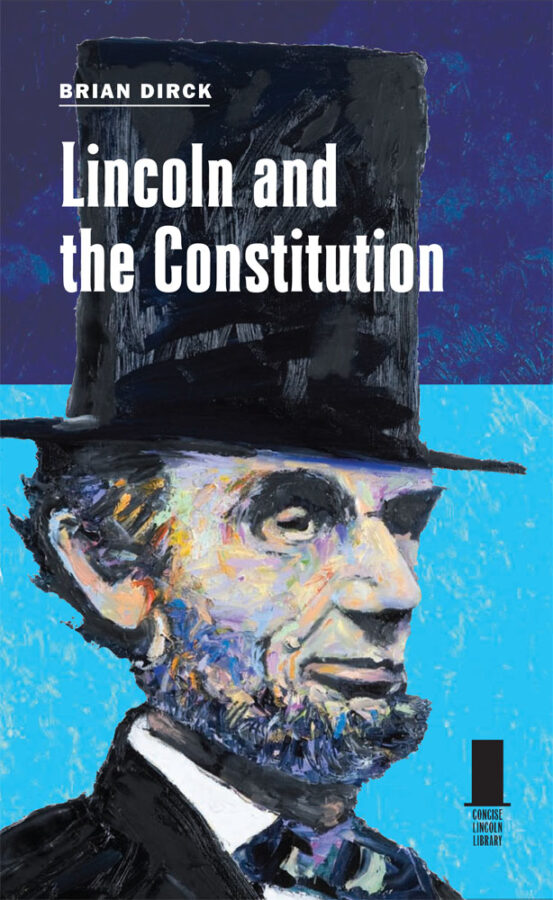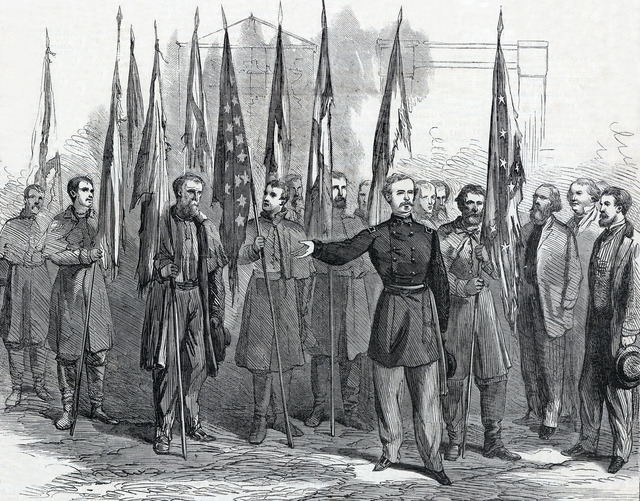Lincoln and the Constitution by Brian R. Dirck. Southern Illinois University Press, 2012. Cloth, ISBN: 0809331179. $19.95.
 In his contribution to Southern Illinois University Press’s “Concise Lincoln Library” series, historian Brian R. Dirck promises readers a book that is “relatively straightforward and basic: an overview of Lincoln’s constitutional thought, spanning his entire lifetime,” accessible to a “general reading audience” (3). In under 150 pages, Dirck delivers. Lincoln and the Constitution is a rich, creative, and utterly readable rendering of the development of Abraham Lincoln’s constitutional theory from which scholars, too, can benefit. I thoroughly enjoyed reading Lincoln and the Constitution, and I learned a great deal from it.
In his contribution to Southern Illinois University Press’s “Concise Lincoln Library” series, historian Brian R. Dirck promises readers a book that is “relatively straightforward and basic: an overview of Lincoln’s constitutional thought, spanning his entire lifetime,” accessible to a “general reading audience” (3). In under 150 pages, Dirck delivers. Lincoln and the Constitution is a rich, creative, and utterly readable rendering of the development of Abraham Lincoln’s constitutional theory from which scholars, too, can benefit. I thoroughly enjoyed reading Lincoln and the Constitution, and I learned a great deal from it.
Dirck begins by reminding readers that “American constitutionalism during the Civil War was filled with blind spots and unforeseen eventualities” (3) to which the sixteenth president had to respond in unprecedented ways. Lincoln’s responses, Dirck goes on to explain, grew out of a combination of his “essentially optimistic view” (5) of the Constitution, his commitment to “certain timeless principles” he believed the Constitution embodied—“the rule of law, the efficacy and wisdom of democracy, the basic liberty endowed to all citizens”—and his faith in the Constitution’s underlying values “for advancing that which was good and just” (5) in American society. In eight chapters plus an epilogue, Dirck then traces the progress of Lincoln’s constitutional thinking from Springfield to Appomattox. Among the many impressive features of this book is the mass of relevant material (both primary and secondary) that Dirck has considered. And although much of this material may initially seem familiar, Dirck engages it in thoughtful and interesting ways, and generates illuminating, nuanced conclusions.
In his early days as a lawyer, Dirck tells us, Lincoln derived the core of his constitutional thought from his observations about how the law, in general, functioned in “the everyday lives of ordinary Americans” (9). In Springfield, Dirck writes, Lincoln came to understand the U.S. Constitution in very practical terms, as “a vigorous, flexible instrument” that both possessed “the latent power in its language to meet the exigencies of new times and challenges” and also firmly and purposefully limited the federal government’s opportunities to exert unnecessary influence (or force) over state and local governments (11). In the 1830s and ‘40s it was this interpretation of the Constitution that enabled Lincoln to hate slavery and yearn for its demise, on the one hand, while simultaneously accepting its persistence below the Missouri Compromise Line, denouncing radical abolitionists, and defending slaveholders as part of his legal practice, on the other.
Steady westward territorial expansion, however, raised inescapable new questions about the Constitution’s position on slavery’s potential spread. As he sought answers to these questions in the 1850s—and particularly after the Kansas Nebraska Act of 1854—Lincoln began to recognize in the promises of the Declaration of Independence an additional tool for interpreting the Constitution, and the Founders’ long-term vision for the nation. In doing so, he came to see the Constitution as “a fundamentally antislavery document” (28), and the Founders as “reluctant enablers of an institution that they secretly detested” (48). It was this augmentation of his earlier perspective that increasingly allowed Lincoln to openly challenge, on a constitutional basis and with deepening fervor, the horrible Dred Scott decision and its author, Chief Justice Roger B. Taney, as well as the decision’s disturbing implications for the future of the peculiar institution and its greatest victims.
For the duration of his short life, Abraham Lincoln never relinquished his personal faith in the Declaration of Independence as an important lens through which to read the Constitution, particularly on the issues of slavery and, ultimately, the future of the freedpeople. But as president and commander in chief beginning in the spring of 1861, Lincoln studied the Constitution anew for guidelines that would legitimately and effectively empower the national government to prosecute (and win) a war against a massive domestic rebellion. In this context, the concept of “perpetual Union” became his primary interpretive lens, and preservation of that Union became, in his updated reading, the preeminent reason why the Founders had infused the Constitution with a certain degree of “elasticity” (73). During the war these twin constitutional principles undergirded Lincoln’s deft handling of a diverse range of issues, such as Chief Justice Taney’s attempt to outfox him on habeas corpus, western Virginia’s quest for secession from Secessia, and, of course, Emancipation.
As Dirck points out, over the course of the war Lincoln’s developing constitutional theory sometimes confounded observers, some of whom (especially among the Radicals in Congress) perceived him as a failed leader, “a bundle of contradictions” who lacked direction all together (106). But Dirck understands Lincoln very differently, not least on the question of freeing the slaves. What appeared (and still appears) to some to be inconsistency in Lincoln’s statements and actions prior to his promulgation of the preliminary Emancipation Proclamation, Dirck argues persuasively, was, rather, a manifestation of the careful but nevertheless steady and logical evolution of his constitutional thought in the face of the war’s own dramatic twists and turns. Having debated for many months whether Emancipation—about which he had consistently held such strong moral convictions—could “be justified as a necessary war measure, and therefore as an acceptable exercise of [his] Article II, Section 2 powers as commander in chief,” by summer 1862, Lincoln finally “reached a point where the answer was yes” (109). And the fact that it took time for Lincoln to reach this point, Dirck insists, is both entirely reasonable and supremely human. “The simple fact,” Dirck explains,
was that Lincoln was groping—groping for victory in an increasingly brutal war, groping towards some new vision of a slave-free America that might or might not include some version of racial equality, groping perhaps also for a new sense of himself as a white man who had lived an entirely life to that point privileged and protected by his white skin (112).
As such, “It is hardly surprising that he said and did contradictory things” along the way to his new consciousness. By late 1862, however, his constitutional vision gave Lincoln “the strength to do what was necessary—to free the slaves with no help from Congress, certainly no help from the Supreme Court, no help from the state governments, and in the face of a divided, heavily bigoted white Northern public” (112-113).
There is much more to Lincoln and the Constitution than I can convey in this short review, including a careful consideration how Lincoln’s evolving constitutional thought shaped his understanding of the Confederacy’s legal standing and the meaning of citizenship for those who had rebelled against the national government, as well as for those whose subordination and bondage Confederate rebels had fought, unsuccessfully, to perpetuate. In his musings on how Lincoln would have handled postwar Reconstruction—a question I myself have often been asked as a consequence of my own scholarly interests—Dirck makes clear that Lincoln’s thinking would have evolved again, by necessity. In the weeks and months after Appomattox, Lincoln would have been operating in a very different context, under the very different conditions of “peacetime,” with its predictable rebalancing of the powers of the national government’s executive, legislative, and judicial branches, not to mention an abundance of white Southerners’ bitterness over the Confederacy’s defeat. In the end, Dirck is persuaded that Lincoln “would likely have spent his second term slowly but steadily gravitating towards the Radical [Republican] position,” particularly “in areas related to the freedmen and their civil rights” (132). This, Dirck suggests, would have been the inexorable result of Lincoln’s “powerful sense of the Constitution’s capacity for expansion and development” as well as his “equally powerful sense of the moral content, the right and the wrong of things,” and “the place this moral sense occupied in his constitutional thought” (134). I am grateful to Brian Dirck for providing such an eloquent articulation of what I have long believed to be the path Lincoln (and the nation) would have taken, if only John Wilkes Booth had abandoned his plans for that terrible evening at Ford’s Theater.
Elizabeth D. Leonard is the John J. and Cornelia V. Gibson Professor and chair of the History Department at Colby College in Waterville, Maine. She is the author of five books on the Civil War era, most recently Lincoln’s Forgotten Ally: Judge Advocate General Joseph Holt of Kentucky (2011), which won the 2012 Gilder Lehrman Lincoln Prize.
